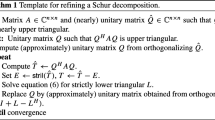Abstract
We describe a procedure for determining a few of the largest singular values of a large sparse matrix. The method by Golub and Kent which uses the method of modified moments for estimating the eigenvalues of operators used in iterative methods for the solution of linear systems of equations is appropriately modified in order to generate a sequence of bidiagonal matrices whose singular values approximate those of the original sparse matrix. A simple Lanczos recursion is proposed for determining the corresponding left and right singular vectors. The potential asynchronous computation of the bidiagonal matrices using modified moments with the iterations of an adapted Chebyshev semi-iterative (CSI) method is an attractive feature for parallel computers. Comparisons in efficiency and accuracy with an appropriate Lanczos algorithm (with selective re-orthogonalization) are presented on large sparse (rectangular) matrices arising from applications such as information retrieval and seismic reflection tomography. This procedure is essentially motivated by the theory of moments and Gauss quadrature.
Similar content being viewed by others
References
M. Berry, Multiprocessor sparse SVD algorithms and applications, PhD thesis, The University of Illinois at Urbana-Champaign, October 1990.
M. Berry, Multiprocessor sparse SVD methods for information retrieval applications, in:Science and Engineering on Supercomputers ed. Eric J. Pitcher (Computational Mechanics Publications, Southampton, Springer-Verlag, Berlin, 1990) 133–144.
R. Bording, A. Gertsztenkorn, L. Lines, J. Scales and S. Treitel. Applications of seismic travel-time tomography, Geophys. J. R. Astr. Soc. 90 (2) (1987) 285–304.
J.K. Cullum and R.A. Willoughby,Lanczos Algorithm for Large Symmetric Eigenvalue Computations, Vol. 1 Theory (Birkhäuser, Boston, 1985).
I.S. Duff, R.G. Grimes and J.G. Lewis, Sparse matrix test problems, ACM Trans. Math. Software 15 (1989) 1–14.
S. Deerwester S.T. Dumais, G.W. Furnas, T.K. Landauer and R. Harshman, Indexing by latent semantic analysis, Journal of the American Society for Information Science, 41 (6) (1990) 391–407.
S.T. Dumais, G.W. Furnas and T.K. Landauer, Using latent semantic analysis to improve access to textual information, in:Proc. Computer Human Interaction '88, 1988.
W. Gautschi, On generating orthogonal polynomials, SIAM J. Sci. Stat. Comput. 3 (3) (1982) 289–317.
G.H. Golub and M.D. Kent, Estimates of eigenvalues for iterative methods, Mathematics of Computation 53 (188) (1989) 619–626.
G. Golub and W. Kahan, Calculating the singular values and pseudoinverse of a matrix, SIAM J. Numer. Anal. 2 (3) (1965) 205–224.
G.H. Golub, F.T. Luk and M.L. Overton, A block Lanczos method for computing the singular values and corresponding singular vectors of a matrix, ACM Transactions on Mathematical Software 7 (2) (1981) 149–169.
G. Golub and C. Van Loan,Matrix Computations, 2nd ed. (Johns Hopkins, Baltimore, 1989).
G.H. Golub and R.S. Varga, Chebyshev semi-iterative methods, successive overrelaxation methods, and second order Richardson iterative methods, Numer. Math. 3 (1961) 147–168.
C. Lanczos, An iteration method for the solution of the eigenvalue problem of linear differential and integral operators, J. Res. Nat. Bur. Standards, 45: 4 (1950) 255–282.
L. Mirsky, Symmetric gage functions and unitarily invariant norms, Quart. J. Math. 11 (1960) 50–59.
B.N. Parlett,The Symmetric Eigenvalue Problem (Prentice Hall, Englewood Cliffs, NJ, 1980).
B.N. Parlett and D.S. Scott, The Lanczos algorithm with selective reorthogonalization, Math. Comp. 33 (1979) 217–238.
J.A. Scales, P. Dochery and A. Gerszternkorn, Regularization of nonlinear inverse problems: imaging the near-surfaceweathering layer, Inverse Problems, 6 (1) (1990) 115–131.
J.A. Scales and A. Gerszternkorn, Robust methods in inverse theory, Inverse Problems 4 (1988) 1071–1091.
H. Simon, Analysis of the symmetric Lanczos algorithm with reorthogonalization methods, Lin. Alg. and Its Appl. 61 (1984) 101–131.
Author information
Authors and Affiliations
Additional information
This author's work was supported by the National Science Foundation under grants NSF CCR-8717492 and CCR-910000N (NCSA), the U.S. Department of Energy under grant DOE DE-FG02-85ER25001, and the Air Force Office of Scientific Research under grant AFOSR-90-0044 while at the University of Illinois at Urbana-Champaign Center for Supercomputing Research and Development.
This author's work was supported by the U.S. Army Research Office under grant DAAL03-90-G-0105, and the National Science Foundation under grant NSF DCR-8412314.
Rights and permissions
About this article
Cite this article
Berry, M., Golub, G. Estimating the largest singular values of large sparse matrices via modified moments. Numer Algor 1, 353–373 (1991). https://doi.org/10.1007/BF02142380
Received:
Issue Date:
DOI: https://doi.org/10.1007/BF02142380




